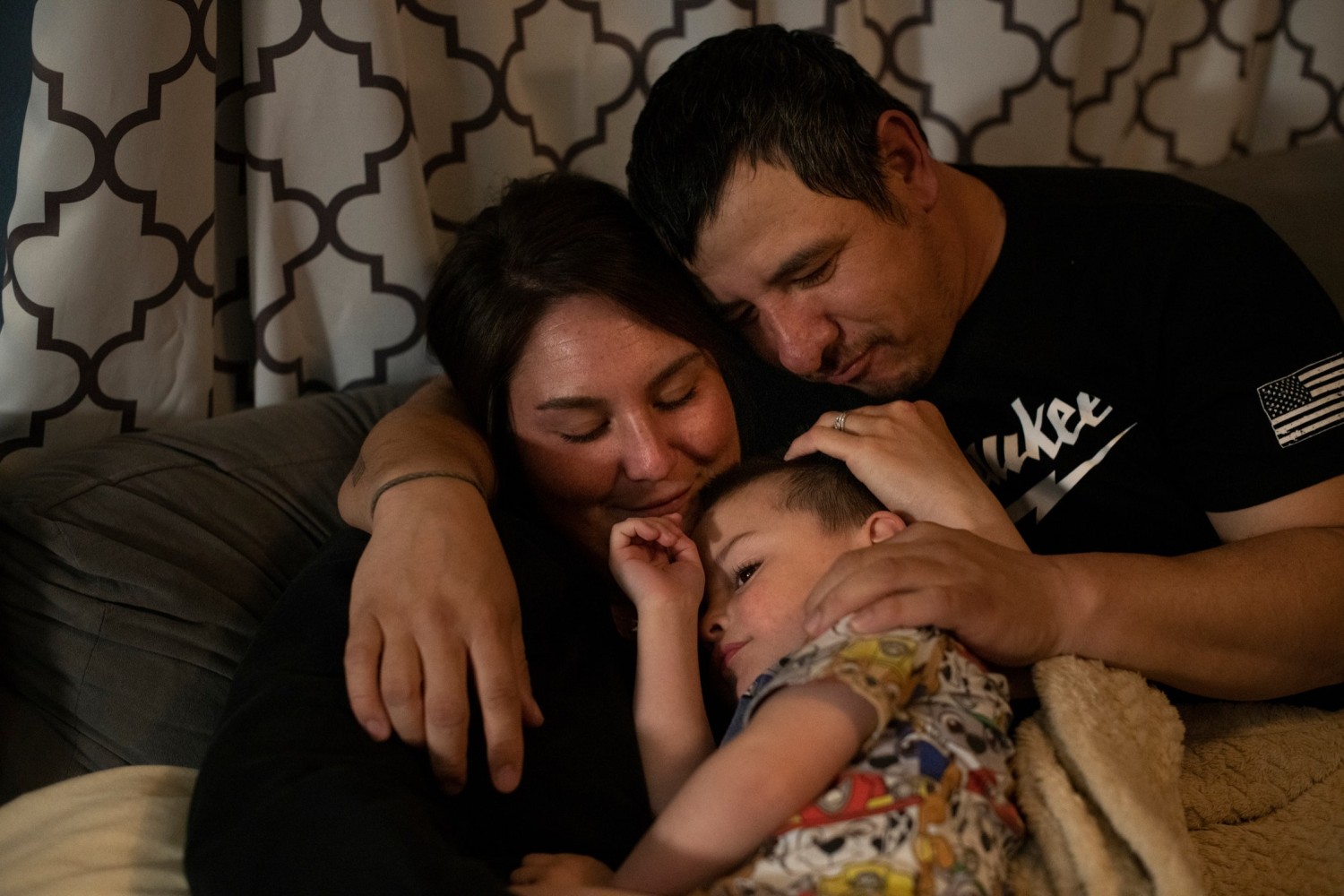
This article is more than
2 year oldWhen Foster Parents Don’t Want to Give Back the Baby

|
By Eli Hager This article is a collaboration between The New Yorker and ProPublicaAlicia Johansen spent her childhood moving with her drug-addicted mom from one place to the next, trying to brace herself for the moment when the water and the electricity would get cut off. So at twenty-two, when she had a chance to run Dolittle’s pool hall, in the ranching town of Akron, Colorado, she was intent on making some money. She kept the bar open deep into the night, after the older guys who bet on horse races departed, and the truckers and the younger crowd, with the meth, drifted in. Meth, she soon discovered, helped her work longer hours. An occasional customer was Fred Thornton, a former high-school baseball star in his early thirties. Fred was sometimes a roofer and at other times unemployed and homeless. They began dating casually and using together, and he told her of his own complicated childhood: placed in foster care as a toddler, after allegations of neglect, and later adopted. Alicia’s period was irregular because of the meth, which also dimmed her self-awareness. She was six months along before she realized that she was pregnant; a month after that, she woke up in pain. She had preeclampsia, which caused dangerously high blood pressure, and needed an immediate C-section. She was airlifted to a hospital in Denver, a hundred miles away. Her and Fred’s son, Carter James Thornton, was born on August 6, 2019—two and a half months premature, two and a half pounds in weight, and, according to his lab work, exposed to meth and to THC. That first week at the hospital, Alicia hovered over Carter, who was curled beneath a web of tubes and wires, before going home to get baby things. The third week, she and Fred visited their son and held him skin-to-skin. The fourth week, back in Akron, they faltered: they had no gas money for a return to the big city; they were bickering; they were high. On the fifth week, when Carter was stable enough to leave the neonatal intensive-care unit, Alicia returned, but foster parents from Akron were the ones who took him home. Carter’s drug exposure and his parents’ weeks-long absence had triggered a call to child-protective services, and then a neglect case against Alicia and Fred in the juvenile court of Washington County, where they lived. To get their son back, the judge informed them, they’d need to take a series of steps laid out by the county’s human-services department: pass random urinalysis drug tests, with missed ones considered positives; secure stable housing and employment; and make it to regular supervised visits with Carter. During the next three months, as the department steadily recorded Alicia and Fred’s positive drug tests and missed visits, none of their excuses were entertained, a hard line for which they would later be grateful. In December, they decided that if they wanted to raise their child together—and they did—they would have to get sober for good. By the summer of 2020, Alicia and Fred had met every one of the judge’s requirements, and then some. They’d tested negative on more than thirty consecutive drug screens between them, including hair-follicle tests that indicated how long they’d been clean. They had continued to visit Carter weekly through the first months of the pandemic, when a “visit” meant trying to entertain an infant over Zoom. Fred took a job as a maintenance man for the county, installing plumbing in low-income housing and mowing the fairgrounds. Alicia left bar work, and began delivering mail for the U.S. Postal Service and manning the deli counter at a grocery store on her days off. They spent much of what they earned replacing carpets, repainting walls, and fogging air ducts to remove any lingering trace of meth from their one-story house, which, before Carter’s arrival, at times lacked water and electricity. They had completed parenting lessons and were in therapy, getting support for their sobriety and learning how to be better partners to each other. In other words, the foster-care system, whose goal under federal law is to be temporary, in service of a family reuniting, seemed to be working. As the couple hit six months sober, the county’s Department of Human Services added, and the judge approved, one more element to their treatment plan: an expert evaluation of how well they interacted with Carter. If they cleared this last hurdle, Alicia and Fred understood, the system would let them reclaim their son. Alicia worried in advance about whether she could be silly with her baby while under scrutiny, and with everything to lose. She would have been more anxious had she known the truth: that she and Fred weren’t just demonstrating their fitness to care for Carter—they were competing for him. His foster parents, hoping to adopt him, had just weeks earlier embraced an increasingly popular legal strategy, known as foster-parent intervening, that significantly improved their odds of winning the child. It has become harder and harder to adopt a child, especially an infant, in the United States. Adoptions from abroad plummeted from twenty-three thousand in 2004 to fifteen hundred last year, largely owing to stricter policies in Asia and elsewhere, and to a 2008 Hague Convention treaty designed to encourage adoptions within the country of origin and to reduce child trafficking. Domestically, as the stigma of single motherhood continues to wane, fewer young moms are voluntarily giving up their babies, and private adoption has, as a result, turned into an expensive waiting game. Fostering to adopt is now Plan C, but it, too, can be a long process, because the law requires that nearly all birth parents be given a chance before their rights are terminated. Intervening has emerged as a way for aspiring adopters to move things along and have more of a say in whether the birth family should be reunified. |
|
Intervenors can file motions, enter evidence, and call and cross-examine witnesses to argue that a child would be better off staying with them permanently, even if the birth parents—or other family members, such as grandparents—have fulfilled all their legal obligations to provide the child with a safe home. When Carter’s foster parents intervened in the hope of keeping him, they turned to the firm of Tim Eirich, a Denver adoption attorney who charges as much as four hundred dollars an hour and has almost single-handedly systematized intervention in Colorado. A video of the two-hour parenting evaluation that would help determine who would raise Carter shows Alicia and Fred sitting on the floor of a utilitarian playroom in a government building, smiling, and their son, now almost one, grabbing Fred’s baseball cap and chewing on it. Alicia feeds him a bit of red bell pepper, explaining to the evaluator, who sits in a chair just off camera, that an occupational therapist suggested that they introduce Carter to new food textures. Both parents cheer as Carter scootches around, and, intermittently, they answer questions that the evaluator poses in a warm Texas accent. What do they think a successful transition from foster care would look like? How would they characterize Carter’s personality? (“Curious,” “Easy to soothe.”) At one point, Fred confides that the playroom has sparked a memory of his birth mother in a similar space, her black hair down to her waist, shortly before she was erased from his life. After the visit, the evaluator, a social worker named Diane Baird, made a report to the county. Alicia and Fred were kind to Carter, she noted, and she praised them for remaining sober and being “earnest in their regret” about the mistakes they had made. But she criticized them for repeatedly encouraging Carter to crawl, which he wasn’t quite ready to do, and for giving him the bell pepper—actions, Baird said, that betrayed a lack of understanding that he had developmental delays. “Neither parent has the kind of relationship with Carter that will help him feel safe in a new situation,” she wrote. When Alicia read the report, she was bewildered. Did Baird not understand how hard it is to bond with a baby you’ve been allowed to see for only a few hours a week, while masked, or in fifteen-minute stints on Zoom? And why was Carter’s eye contact with her, which Baird had specifically praised during the visit, now described as lacking “affective involvement”? But she and Fred decided to focus on the practical advice that Baird had given them, including not to fall silent around Carter and to face his developmental delays instead of avoiding them. After a follow-up evaluation a month later, Baird reported that Alicia’s knowledge of child development was deepening, and that she and Fred had engaged in imaginative play, as when Fred aced a feeding game by using a toy dinosaur. Nonetheless, Baird opposed Carter’s being returned to Alicia and Fred, on the ground that the foster-parent intervenors had reported that he pitched fits and struggled to eat and sleep after seeing them. Although hired as a consultant by Washington County in this case, Baird had a long-standing independent agenda: helping foster parents across Colorado succeed in intervening and permanently claiming the children they care for. Often working hand in hand with Tim Eirich, she has been called as an expert in, by her count, hundreds of child-welfare cases, and she sometimes evaluates visits between birth families and children without having met them. Baird would not say how many foster-parent intervenor cases she has participated in, but she can recall only a single instance in which she concluded that the intervenors should not keep the child. Thinking that particular couple would be weak adoptive parents, she told me, she simply filed no report. In front of the judge in Carter’s case, Baird elaborated on the danger of returning Carter to Alicia and Fred, saying that their visits with him were threatening his primary attachment and causing “a biologic hyperarousal that not only burns calories but self-perpetuates”—a state that becomes worrisome when a child spends “twenty-five to fifty-seven per cent of their time, or whatever,” in it. Rupturing a primary attachment could ultimately cause “sociopathy” in a child, she said. In February, 2021, relying heavily on this expert view, the county moved to permanently terminate Alicia and Fred’s parental rights. All that remained was a hearing in which the judge would make a decision, and, as it approached, the couple felt outmatched. Akron being a small town, they knew something about the people who’d been fostering Carter. Lain Bernhardt, who came from a prominent local ranching family, had once run for mayor. He and his wife, J’Lyn, were teachers, he in the public-school system, she at a Head Start program run by a Methodist church. They lived on a farm, and Alicia could concede that Carter, now a year and a half old, might have a pretty decent life there. But she also knew that, even at the lowest points of her own childhood, she hadn’t wanted to lose her mom forever, as Fred had done. Fred, a Mexican American who had been adopted by a white family, worried that Carter would grow up as tormented about his cultural identity as Fred had been, and as uncertain about whether his birth family fought to keep him. Although he and Alicia sensed that some fix might be in, they promised each other not to give up. Even if they lost, they reasoned, Carter might one day know that he’d been wanted. In the nineteen-fifties, the British psychoanalyst John Bowlby posited that being separated from a maternal figure in the first years of life warps a child’s future ability to form close relationships. He and other psychologists later added nuance to what became known as “attachment theory,” taking into account new research, such as a longitudinal study of children who’d spent their early years in residential facilities, which indicated that some children had more resiliency than Bowlby had initially grasped. In the ensuing decades, the idea that breaking off a primary attachment would do lifelong damage became influential in child-development spheres, and eventually infiltrated popular culture. Early in this century, several adoption attorneys “hit on this thing of attachment” and saw its utility, Dale Dove, who co-chairs the Academy of Adoption & Assisted Reproduction Attorneys’ foster-care committee, told me. With the supply of adoptable babies dropping, foster children were becoming a “hot commodity,” he said, and he and his colleagues (among them Tim Eirich’s law partner Seth Grob) realized that attachment experts could be called into court to argue that foster children needed to remain with their foster parents in order to avoid a severed bond. In actuality, young children may endure a range of caregiver transitions, including being removed from birth parents and sent to foster care in the first place, or going through a private adoption or a divorce. When the American Academy of Pediatrics reviewed recent research, it concluded that kids who grow up with their birth family or kin are less likely than those who are adopted or are raised in non-kinship foster care to experience long-term separation trauma, behavioral and mental-health problems, and questions of identity. The Trump and Biden Administrations have both pressed states to keep a larger percentage of kids with birth parents or kin. Intervention, a state-level counter-trend, is supported by foster-parents’-rights groups and advocates at national conservative organizations. Naomi Schaefer Riley, an American Enterprise Institute senior fellow, has criticized the fact that some states extend the year and a half that federal guidelines give birth parents to rehabilitate themselves. Intervention, she says, helps stop that foster-care drift, reduces cavalier reunifications in which children taken away after abuse and neglect are returned to the same circumstances, and clears the path to adoption. Since 2018, South Carolina’s courts and lawmakers have affirmed the right of any state resident to file to adopt any foster child, as well as the right of foster parents to intervene. In 2020, Kentucky amended its law to let foster parents intervene as legal parties in involuntary terminations of birth parents’ rights. And this year Florida passed a law saying that if birth parents move to have their child adopted, including by a biological family member, long-term foster parents can intervene to contest that outcome. Kathryn Fort, the director of the Indian Law Clinic at Michigan State University, told me that her practice has faced three sets of intervenors this year, all of them non-Native couples seeking to adopt a Native child. Colorado has been a pioneering state for intervention thanks mostly to Eirich, the lawyer whose firm represented Carter’s foster parents. In 2013, he argued and won a state Supreme Court case that ended almost all limitations on the practice, and in the following five years there was a threefold increase in intervenor cases statewide, according to data from the Colorado Office of Administrative Courts. By 2022, at least twenty-five hundred cases had been filed. A tenth of the state’s child-welfare cases now have an intervenor. And with an intervenor, court data indicate, the chance that the birth parents’ rights will be terminated surges from seventeen per cent to forty-three per cent. Bruce Boyer, Eirich’s former professor at the Loyola University Chicago School of Law, told me that he has become concerned about intervenors “bullying their way” into proceedings in which the termination of parental rights, a grave state power, is on the line. Eirich’s firm represents nine private-adoption agencies across Colorado, and he leads intervenor-training sessions for judges and foster parents. He told me that the idea that he helps adopters-to-be thwart the goal of birth-family reunifications is “absolute bullshit.” Most of his clients intervene, he said, primarily in order to help the judge make an informed placement decision: one that considers the child as an individual, instead of prioritizing generalized arguments about biological ties or race. “Colorado empowers people who care about maltreated children to be part of the process,” he says. He routinely relies on Diane Baird, whom his clients sometimes hire directly, or on an attachment expert whom she has trained. Baird told me that she decided to work so closely with Eirich because “he knew how to use me most effectively.” They both often argue that birth-family visits are causing a child damaging emotional swings due to attachment issues. “A healthy attachment trumps biology in the first three years of life, period,” Baird told me. Later, she e-mailed me something that one of her colleagues likes to say about biological families: “Blood is thicker than water but it’s also a better carrier of disease,” to which Baird added, “LOL.” It’s not acceptable in most family courts to explicitly argue that, if you have more material advantages to provide a child, you should get to adopt him or her. Outside the courtroom, though, intervenors are sometimes less discreet. During a 2021 case meeting, according to a specialist who took notes, a foster parent and Eirich client said, of the prospect of reuniting a baby boy with his biological family, “He’s used to being raised by a maternal figure who stays home. We have one and a half acres for him to run around, and they have an apartment.” Another foster parent and Eirich client told me that reuniting a baby girl with her birth mother would mean transitioning her from a “personalized nanny” to a “day-care center with, you know, fifty kids running around, and sleeping on a little cot.” When Carter was ready to leave the hospital, in September, 2019, J’Lyn and Lain Bernhardt walked into his room in the nicu and found Alicia sitting there, seemingly disengaged from her stunningly small child. Alicia jumped up and thanked them for taking in Carter. As they all watched child-safety videos, the Bernhardts did their best to be polite, but they later told me how effortful that had been. “You choose drugs over your child,” Lain said, “and my opinion about you is not going to be positive.” The Bernhardts care deeply about children. J’Lyn has focussed her career on early-childhood education, and Lain, in his mayoral campaign, advocated for after-school programs for older kids. But since they got married, as twenty-three-year-olds, in 2015, they haven’t had biological children of their own. Realizing that, as they put it, there were plenty of children in this country who needed help, they registered with the county as what is called a foster-to-adopt family, stating their willingness to adopt but agreeing that birth parents must first be given a chance to follow their court-ordered treatment plan. Before Carter, the Bernhardts fostered eight kids, one or two at a time, a draining public service for which they received a monthly payment of around a thousand dollars. In 2018, they adopted one of the children, an eleven-year-old boy. But Carter was their first newborn. He was so underweight that he needed a special high-calorie formula, which he struggled to consume. “It takes over every part of your body that this is an innocent child, and he is here by himself,” J’Lyn told me. Lain said, “People tell you, ‘It’s foster care . . . it’s temporary.’ ” But nothing about the situation felt temporary, he said. Within days of learning that Carter, at the hospital, needed foster parents, J’Lyn came to work full of emotion, saying that she needed time off because she was getting a baby who’d be fast-tracked for adoption, according to her supervisor at Head Start. (J’Lyn disputes this account.) Before long, she and Lain bonded with Carter; the first time he sat up and the first time he broke into giggles, they cried. |
|
The job of foster parents is inherently difficult on an emotional level. They are told that they’re needed because a child’s parents have severe and potentially dangerous problems, but also that they should support the ultimate goal of returning the child to those same parents. They’re expected to simultaneously love the child and accept that their bond with the child may be broken. And although they may spend all day, every day, with the child, a caseworker usually has more influence than they do in determining what’s in the child’s best interests. Intervening makes some foster parents—whether they went into the process looking to adopt or arrived at that desire over time—feel less helpless. When the Bernhardts started Googling intervention, they quickly found Eirich’s Web site and many effusive reviews from foster families who had won contested adoptions with his help. “He’s the one who fought for us to have this right,” Lain told me. But Eirich was too busy to represent them, so they hired his associate Kerry Simpson, with whom Eirich discussed the case as it went along. The Bernhardts, in their motion to intervene, argued that Carter might develop an attachment disorder if separated from them, and said that they were concerned about whether his developmental needs would be handled appropriately if there were a change in caregivers. “Cognitive disability and/or autism is likely,” the filing said. Read More (...) |






